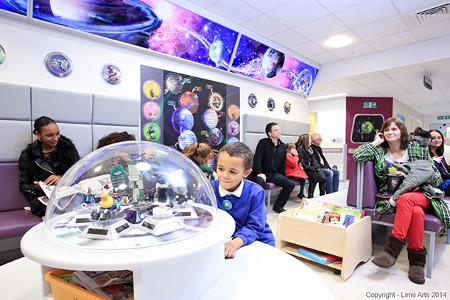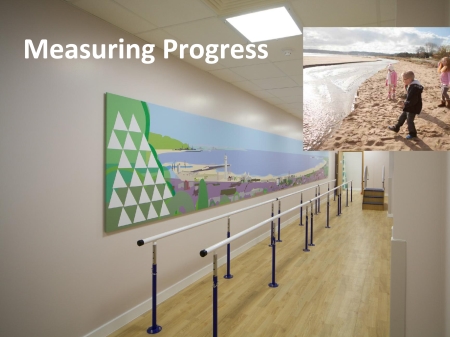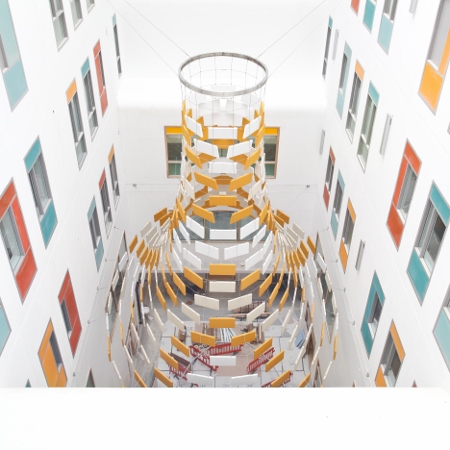Incorporating the arts into health and social care settings is increasingly becoming a priority for providers. Here we look more closely at this growing trend
Numerous studies have been carried out that show how incorporating art into the design of healthcare environments can benefit patients, staff, and visitors, both physically and mentally.
As well as promoting rest and relaxation, the inclusion of artwork and participatory arts programmes within hospitals, health centres, and care homes can help with rehabilitation, reducing the cost of medicine and helping to curb anxiety and aggression. It has also been found to aid staff recruitment and retention.
But, to produce the best results, arts projects must be looked at as more than just a pleasant distraction – a landscape painting hanging on a wall or a fun mural in the waiting room of a children’s outpatients department.
Increasingly, art is being used for things like wayfinding, or to help specialist groups of patients with their recovery.
An example of this approach is evident at the new South Glasgow University Hospital and Royal Hospital for Sick Children, which are currently under construction.
Due for completion later this year, the £840m development includes a major arts project, designed to help people visually navigate the labyrinth of rooms, wards, departments and corridors.
Positioned in a busy multi-use area known as ‘The Podium’, and at the junctions where various ‘streets’ of the hospital intersect, a total of 22 colourful 3D artworks are being placed. These are designed to have a high recognition value and to work in the way that familiar urban landmarks do.
The team responsible for conceiving and creating the artwork included art consultants, Ginkgo Projects; artist, Rachel Mimiec; designers, Graphical House; and interior architects, Haa design.
“In a city there are signs, but sometimes you find your way around by recognising a particular church or statue,” said Chris Fremantle, project manager for Ginkgo Projects.
Finding your way
"The challenge was to create these landmarks in a way that would not only be attractive, but also highly functional, while also being suitable for the sterile interiors of a hospital.” Inspiration for the project evolved through a series of workshops within the local community and at a number of hospitals in the region.
The recurrent theme to emerge was how distinctive objects play a key part in signposting memory.
Our photographs are regularly used to help with wayfinding, an increasingly important area for patient satisfaction as they navigate larger healthcare facilities
For the first time on a project of this type, DuPont’s Corian advanced surface was chosen. All the landmarks have a similar style and identity, a background of Corian in white colour with the designs mounted in colour. Most are large panels that wrap around a corner.
Daniel Ibbotson, director of Graphical House, said: “The panels needed to be striking so you can spot them from the far end of a corridor and recognise them, but they also had to be beautiful once you were up close.”
Arts and health specialist, Willis Newson, took a similar approach at Gloucestershire Royal Hospital, where a new 24m-long panoramic photograph capturing the local skyline is providing enjoyment and distraction to patients, staff and visitors. It is displayed along a corridor linking old and new buildings.
A spokesman for Healing Images, an arts company that uses photography to enhance buildings, added: “Our photographs are regularly used to help with wayfinding, an increasingly important area for patient satisfaction as they navigate larger healthcare facilities.
“We can tell them to ‘go to the waterfall and turn right’ or ‘pass the daffodils and turn left’. As they traverse the healthcare experience, they can experience art as support for the journey and medicine for the spirit.
“Art affects the perception that patients have about the quality of their medical care. That is a powerful proposition.”

The Starship X-ray project helps young patients in the radiology unit at the Royal Manchester Children’s Hospital
An aid for dementia
Dementia care environments are among the most-prolific users of art. With dementia affecting memory and creating anxiety, it is used to help care home residents and hospital patients find their rooms or beds, or to reduce confusion and aggression.
Artwork was central to the revamp, last year, of a 35-bed elderly care ward at Prospect Park Hospital in Berkshire.
There, wall murals celebrating the history and culture of the Reading area were integrated into a refurbishment project.
The work came off the back of a survey in which feedback from staff at the hospital focused on the benefits of artwork for employee morale, and as a catalyst for conversation and a reminiscence tool for patients. In particular, it was seen to be of help to dementia patients who like to wander as it makes the corridors a more-welcoming and less-stressful environment.
The project was developed by Willis Newson and Hunter Design Associates.
Inpatient services manager at Berkshire Healthcare NHS Foundation Trust, Cathy Mills, said: “The artworks really encourage conversation. Patients and visitors instantly identify with them. They chat about places they remember, fashions they used to wear, memories that the pictures spark.
“The ward is also a calmer place. When I see people in the corridors, they are enjoying themselves rather than feeling anxious and lost. Staff are calmer and happier, too and if staff are happier, it rubs off on patients.”
Lime Art has taken a similar approach within a dementia care ward at Bradford Hospital. Using a variety of media, including Perspex, it commissioned a number of artists to design unique artwork for the Horton Wing, which colour experts from Johnstone’s Trade then complemented with a bespoke colour specification.
When I see people in the corridors, they are enjoying themselves rather than feeling anxious and lost. Staff are calmer and happier, too and if staff are happier, it rubs off on patients
Each piece was created around the ‘Yorkshire at its Best’ theme, which incorporated ideas from patients, the public, and local organisations. Together with new signage and a bright interior design approach, the project has helped patients to orientate within the department, as well as enhancing wayfinding.
Another vital function of artwork, and participatory arts such as dance, writing and poetry, is to help with rehabilitation and recovery.
Within a specialist rehabilitation centre at Morriston Hospital in Swansea, art is used as a tool for recovery and, given the seriousness and potentially life-limiting conditions of the patients, to demonstrate what could still be achieved.
The road to recovery
The idea of the artwork was to focus on illustrating, through photography and film, the treatment stages and recovery and to celebrate both the everyday and extraordinary achievements that have been made by some of the long-standing patients.
Photographs of patients undergoing the fitting of a prosthetic leg are sited within the fitting area, for example, so that new patients have a visual concept of the treatment they will be receiving. In the gait analysis room this is complemented by a mural of Swansea Bay, which allows progress in walking to be monitored by means of white movable ‘sails’ that can be annotated with the patient’s name and used to identify the progress achieved over the pathway.
At the Royal Manchester Children’s Hospital, the Starship X-ray project uses the theme of outer space to help relax young patients within the radiology unit.

At Morriston Hospital, patients’ rehabilitation can be measured by their progress along a mural of Swansea Bay
There are nine camera rooms within the department and each has artwork based around a planet in the solar system.
The unique project includes lightboxes, interactive digital play, 3D and 2D displays, large-scale artworks, furnishing and fabrication, signage, changing LED lighting, and a sound installation.
A radiologist in the unit said: “The lightbox that was installed in the CT room came into its own the day after it went in when we had a young boy who had previously really struggled to stay on the scanner lay quietly and count the butterflies and monkeys. His mum was nearly in tears as what has previously been a traumatic experience for them both was completed with ease and he came away smiling for the first time.”
The project was funded by the Thomas Cook Children’s Charity and was led by Lime Arts. But art it not just helping patients and staff. It can also help enhance buildings themselves. For the first time, a sculpture is being used to reduce noise levels and enhance patient privacy at Bristol Royal Infirmary.
Overseen by Willis Newson and designed by Studio Weave, the acoustic-baffling sculpture creates a visual centrepiece to the atrium of a new seven-storey ward block.
Suspended above the hospital’s busy medical assessment unit, the sculpture is made from acoustic-baffling panels that absorb sound from the activity on the ground level while providing additional privacy for patients by shielding sightlines from the upper floors.
Art affects the perception that patients have about the quality of their medical care. That is a powerful proposition
Made from 270 acoustic-baffling panels, the sculpture’s funnel-shaped design allows patients, staff and visitors on the ground floor to still benefit from the light that the atrium provides.
“The sculpture works on many levels. It’s a stunning piece of artwork that creates a visual focal point for the space, but it also solves a lot of practical problems that hospitals have to resolve,” said Deborah Lee, the hospital’s chief operating officer and deputy chief executive.

For the first time, an acoustic-baffling sculpture is being used to reduce noise levels and enhance patient privacy at Bristol Royal Infirmary
